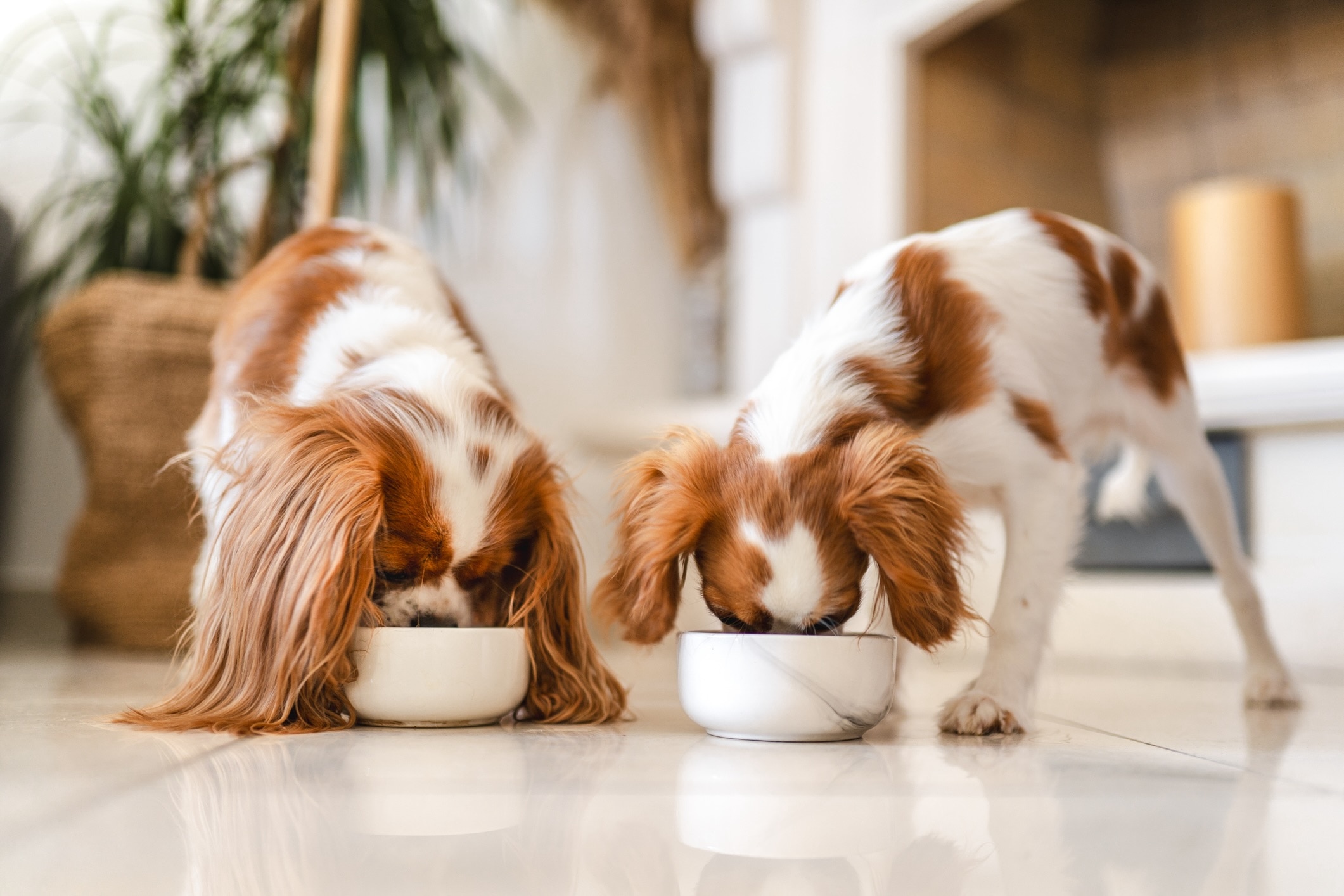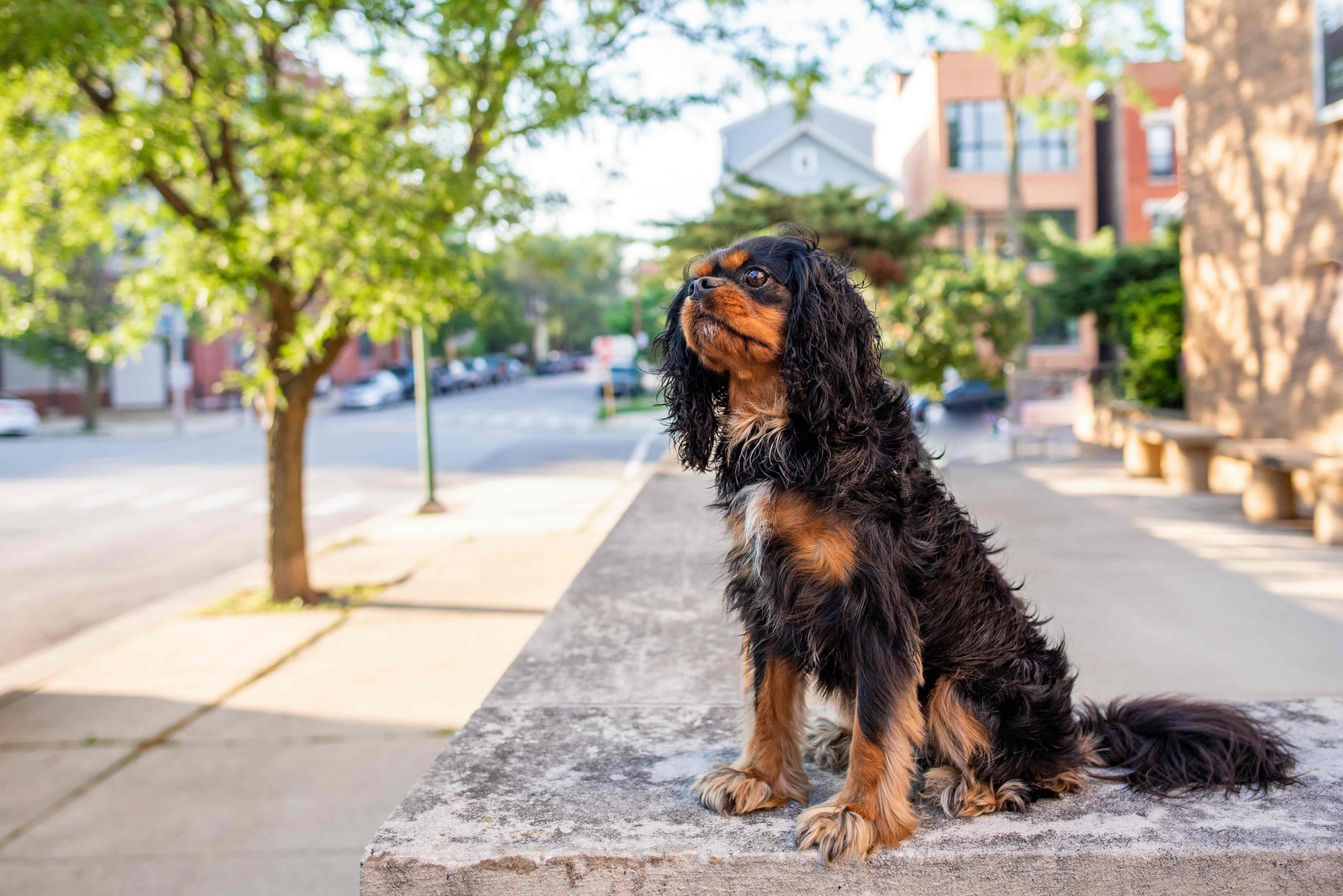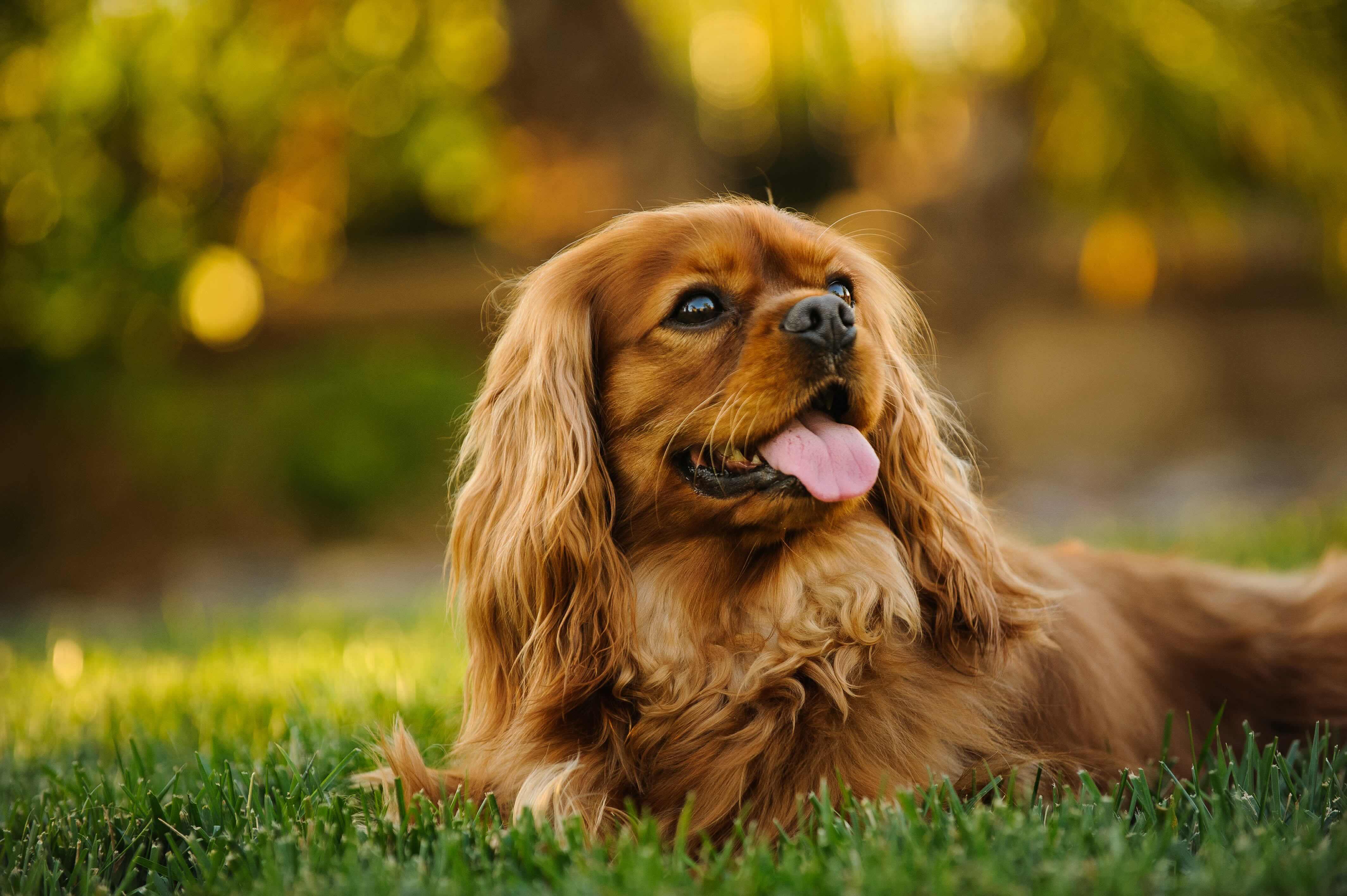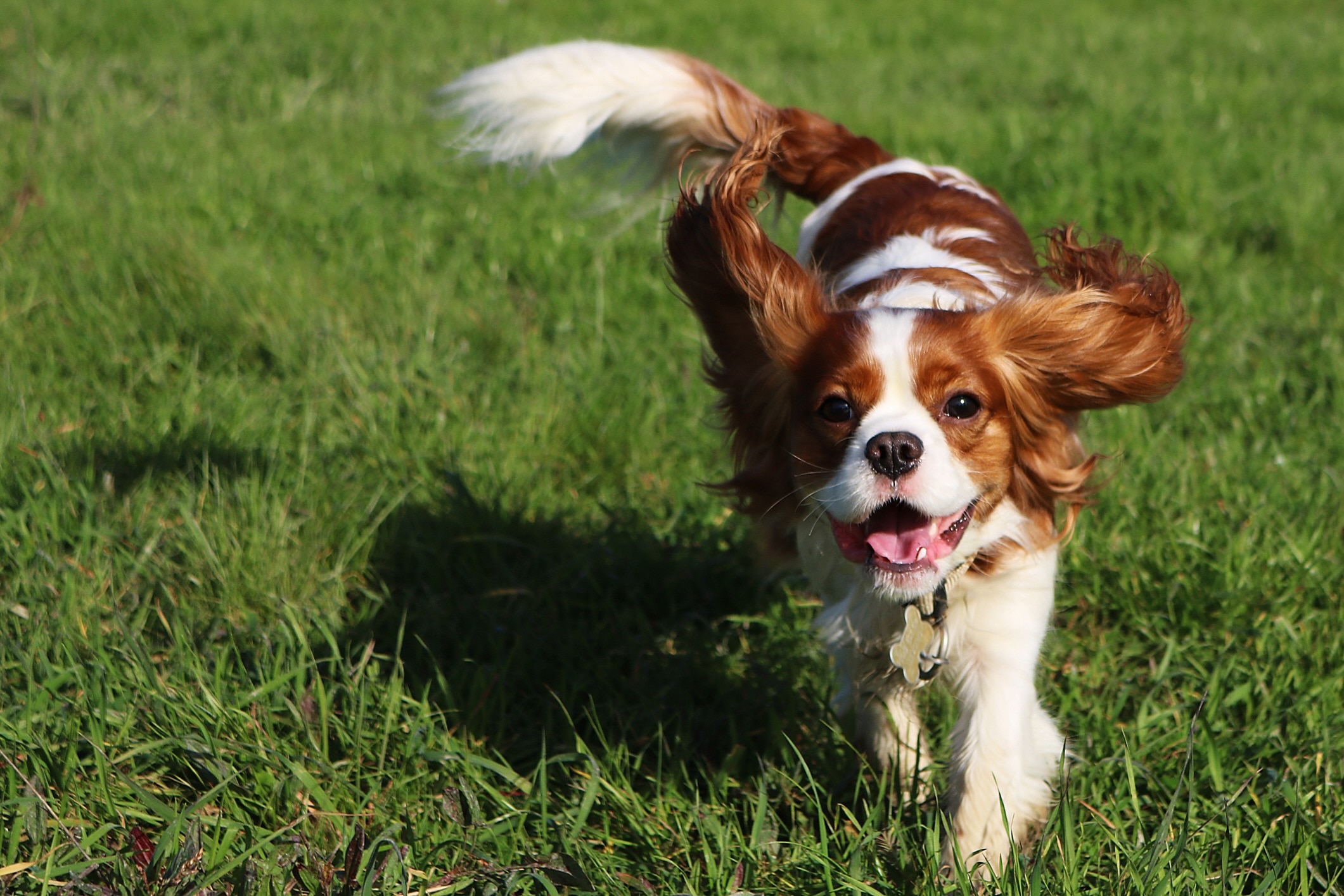Cavalier King Charles Spaniel
iStock/Swanlake
The Cavalier King Charles Spaniel is a loving and affectionate companion dog.
They got their name from British royalty in the 17th century. King Charles I and his son Charles II were so fond of this breed that they took their dogs with them everywhere, including Parliament, according to the Cavalier King Charles Spaniel Club.
Cavalier King Charles Spaniels were bred to warm laps in drafty castles and on chilly carriage rides. The friendly dogs have a gentle nature that makes them an excellent choice for first-time dog parents. They’re currently ranked as the 14th most popular dog breed by the American Kennel Club (AKC).
Caring for Cavalier King Charles Spaniels

Cavalier King Charles Spaniels are small dogs that are typically 12–13 inches tall and weigh 13–18 pounds. They have naturally floppy ears, a long back, compact body, and deep chest. Cavaliers have a smooth, long coat that comes in four colors with distinct patterns:
-
Blenheim Cavalier King Charles Spaniels have reddish-brown and white fur, with a partial red mask, red ears, and red patches on a white body.
-
Tricolor Cavalier King Charles Spaniels are black and white with tan points.
-
Ruby Cavalier King Charles Spaniels are solid red dogs.
-
Black and tan Cavalier King Charles Spaniels have black fur with tan markings.
Their long coat requires weekly brushing to help decrease shedding and to keep it well maintained. They also require frequent professional grooming, so make sure you budget accordingly.
The Cavalier King Charles Spaniel dog breed was created to be a companion, and today they prefer to stick by your side—or be in your lap. Like all dogs, Cavaliers need regular exercise and mental stimulation. But once their energy needs are met, these calm dogs are happy to lounge on the couch with their family.
Cavalier King Charles Spaniel Health Issues

The average Cavalier King Charles Spaniel lifespan is 12–15 years. However, they are prone to several medical conditions and require routine physical exams.
Responsible breeders usually test dogs for any health issues before breeding them, but it may be a good idea to purchase pet insurance when you bring home a Cavalier King Charles Spaniel puppy.
Eye Conditions
Cavalier King Charles Spaniels are prone to eye conditions such as cherry eye, dry eye, retinal problems, and cataracts.
These can be detected through an eye exam, which is noninvasive, painless, inexpensive, and easily performed on the dogs during a routine vet visit. Your veterinarian uses specialized tools to look for any abnormalities to the back of the eye or retina and the surface of the eye. They also check your dog’s ability to produce tears.
Common symptoms of eye problems in Cavalier King Charles Spaniels include:
-
Swelling in the corner of the eye
-
Squinting
-
Bumping into things
Depending on which eye condition is diagnosed, surgery or long-term eye medications might be necessary.
Patellar Luxation
Patellar luxation, or sliding kneecaps, often occur in the Cavalier King Charles Spaniel dog breed. This condition is usually noticed in the first 18 months of life, but it may be diagnosed at any time—even before your dog shows any symptoms.
Patellar luxation causes limping, lameness, and “bunny hopping,” and usually affects both hind legs. Treatment depends on the severity, but often involves anti-inflammatory medications, exercise restriction, and surgery in severe cases.
Hip Dysplasia
Hip dysplasia is another common Cavalier King Charles Spaniel health issue, where the thigh bone does not fit correctly into the hip bone. This can be a genetic condition or caused by environmental factors, such as obesity.
Dogs affected with hip dysplasia often show signs of pain, including limping and lameness, and systemic signs such as lethargy and anorexia are common.
Any dog that’s going to be bred should have their hips evaluated by a veterinarian. This is done using X-rays on dogs as young as 4 months old so Cavalier King Charles Spaniel breeders won’t pass along this genetic condition.
Mitral Valve Heart Disease
Mitral valve disease (MVD) is the leading cause of death in Cavalier King Charles Spaniels. It’s a deterioration of the heart’s mitral valve, which normally keeps blood flowing in the correct direction.
When the mitral valve is not functioning normally, it allows blood to flow backward, causing further deterioration of other parts of the heart muscle. Unlike other dog breeds with MVD, in Cavalier King Charles Spaniels, this condition almost always leads to congestive heart failure.
Signs of MVD include:
-
Exercise intolerance
-
Difficulty breathing
Syringomyelia
Syringomyelia (SM) or “neck scratcher’s disease” is a severe, inherited, progressive neurological disease that is usually diagnosed in Cavalier King Charles Spaniels between 6 months and 3 years of age, but it has been reported in dogs up to 10 years old.
This condition causes fluid buildup around the spinal canal, often from abnormalities of the brain and skull. It’s diagnosed using an MRI scan or by observing the classic clinical signs below.
Symptoms of SM include:
-
Scratching on or in the air near the shoulder when excited or walking on a leash
-
Yelping, whining, or whimpering in pain for no apparent reason
-
Weakness in the legs
-
Head shaking
-
Lip licking
Medical management helps but will not resolve all clinical signs. The only option for dogs with significant symptoms of disease is surgery to help alleviate pain.
What To Feed a Cavalier King Charles Spaniel

Cavalier King Charles Spaniels flourish on a complete and balanced diet that’s compliant with Association of American Feed Control Officials (AAFCO) standards. It’s also important that their food is specifically formulated for a small or toy breed, as the kibble size is a bit smaller and aids in digestion.
Hill’s® Science Diet®, Royal Canin®, and Purina® are among the most recommended brands of dog food. Royal Canin even manufactures dog food specifically made for Cavalier King Charles Spaniels.
Talk to your vet about which food is best for your dog.
How To Feed a Cavalier King Charles Spaniel
Cavalier King Charles Spaniel puppies under 1 year old should eat a special diet formulated for puppies. Puppy food has added nutrients to help mental and physical development during this crucial time of their lives.
Any dog food that’s labeled for “all life stages” should only be used for puppies, as they are not usually formulated for older dogs.
Dogs that are older than 1 year should eat a diet labeled for adult dogs. When your Cavalier King Charles Spaniel reaches 7–8 years old, ask your vet if you could switch to a senior dog food. This type of dog food is often leaner and has added vitamins and supplements, such as glucosamine for joint health.
Consider feeding your adult and senior Cavalier a low-fat or low-calorie diet, as maintaining lean body weight is best for dogs that are prone to orthopedic problems.
How Much Should You Feed a Cavalier King Charles Spaniel?
Cavalier King Charles Spaniel puppies should be fed three to four times a day to prevent low blood sugar. Adult dogs should be fed twice a day.
The amount of food you give your dog depends on several factors, including weight, health, and lifestyle. You can ask your veterinarian, follow the package instructions, or contact the dog food manufacturer (as AAFCO-compliant diets have veterinary nutritionists) to help determine dietary requirements.
Nutritional Tips for Cavalier King Charles Spaniels
In general, if a dog is on a well-balanced, AAFCO-compliant diet, then they are getting all of the necessary vitamins and minerals to grow and develop. But depending on the health and life stage of your Cavalier King Charles Spaniel, they might benefit from nutritional supplements.
Joint supplements such as glucosamine, chondroitin, and methylsulfonylmethane (MSM) are great for joint health. MSM has all-natural, anti-inflammatory properties. Research shows that reducing inflammation helps control pain associated with osteoarthritis, a common problem in dogs with joint issues.
Essential fatty acids such as omega-3 (high-quality fish oil) may have anti-inflammatory properties when given at appropriate doses. They are also known to help support eye and heart health.
Probiotics are also used to help improve digestive health and immunity. A generally healthy dog may not need probiotics, but during times of illness, stress, or malnutrition, probiotics are valuable to help restore balance to the body.
Behavior and Training Tips for Cavalier King Charles Spaniels
Cavalier King Charles Spaniel Personality and Temperament

The Cavalier King Charles Spaniel’s temperament is friendly and loyal. They make great family dogs and are known to be tolerant, patient, and good with other pets and young children.
Although Cavaliers were bred to be lap dogs, they are descendants of the sporting family and enjoy moderate exercise and outdoor activities. They can do well with both active, athletic families and with less active, homebody types who still prioritize their dog’s well-being with daily walks and playtime.
Cavalier King Charles Spaniel Behavior
Cavalier King Charles Spaniels need human interaction and companionship to thrive and should not be left alone for long periods of time. They’re exceptionally friendly, good with both families and strangers, and can do well in many different living situations.
However, it’s not a good idea to let your Cavalier off-leash. A new smell might pique their interest and tempt them to run after it, causing your dog to possibly become lost or hurt. A fenced yard is recommended for a Cavalier King Charles Spaniel.
Cavalier King Charles Spaniel Training
Cavaliers are eager to please and easy to train. They are smart dogs and excel at several canine sports including obedience, AKC Rally®, and agility.
Begin training and socializing your Cavalier King Charles Spaniel puppy as soon as you bring them home. Proper socialization is important for helping puppies grow to be confident and comfortable in new situations as adults. Always use positive reinforcement-based training.
Fun Activities for Cavalier King Charles Spaniels
Cavalier King Charles Spaniel Grooming Guide

Cavaliers are easy to maintain with regular brushing using a bristle or pin brush to ensure the coat maintains its shine and doesn’t get tangled. How often you groom your dog depends on how long you keep your dog’s coat—the longer the dog’s hair coat, the more grooming is required.
Skin Care
Cavalier King Charles Spaniels should be bathed at least once or twice a month to help keep their coat healthy and skin free of irritants. A mild, soap-free, aloe- or oatmeal-based dog shampoo is best to keep their skin healthy and coat shiny.
Coat Care
Cavalier King Charles Spaniels have a long, silky coat that requires regular brushing. Brushing not only helps prevent tangles and matting, but it also serves as a massage and grows the human-animal bond.
Cavaliers don’t shed a lot, but regular brushing will help decrease what shedding does happen. Professional grooming can help reduce the amount of upkeep you need to do at home.
Eye Care
Because some Cavalier King Charles Spaniels have white or light-colored fur around the eyes, they can develop tear stains. Cleaning around your dog’s eyes with a warm washcloth or vet-recommended tear stain remover can help prevent this.
Along with normal tear staining, Cavalier King Charles Spaniels are prone to several health conditions. Check your dog’s eyes during normal grooming sessions and contact your vet if you notice any changes.
Ear Care
Cavalier King Charles Spaniels have long earflaps that are prone to ear infections. When infected, excessive itching and head shaking may cause ear hematomas. This occurs when the tiny blood vessels in the earflap burst, and a pocket of blood develops. It can be resolved by treating the underlying ear infection or with a surgical corrective procedure.
Your Cavalier’s ears should be checked weekly for signs of an infection such as redness, debris, and odor. Mild ear cleaners are recommended to keep the ear canals clean and dry.
Considerations for Pet Parents

Cavalier King Charles Spaniels make great pets for just about any home or lifestyle. They can be active and enjoy frequent exercise, but they can also happily lie on the couch all evening.
Cavaliers are good with other dogs and cats and are happy in a large home or a small apartment. They require a moderate amount of exercise daily; two 20- to 30-minute walks are sufficient.
These dogs are very gentle, playful, and would make a great addition to a home with children. They enjoy playing with tug-of-war toys or running an agility course at the dog park.
They do shed some and have a very long coat, so they need regular brushing and to be groomed professionally a few times a year.
Cavalier King Charles Spaniel FAQs
Is a Cavalier King Charles Spaniel a good family dog?
Yes, Cavalier King Charles Spaniel are known to be great family dogs. They are known to be tolerant and patient, which allows them to get along well with children, cats, and other dogs.
Are Cavalier King Charles Spaniels smart dogs?
Yes, Cavalier King Charles Spaniels are known to be bright dogs that are eager to please their humans, often making them easy to train.
How much does a Cavalier King Charles Spaniel cost?
The average Cavalier King Charles Spaniel price varies and depends on many factors. But in general, you can expect to pay $1,000–$2,500 for a puppy. You might also find Cavalier King Charles Spaniels for adoption at breed-specific rescues.
Is the Cavalier King Charles Spaniel a good choice for an apartment?
Yes, Cavalier King Charles Spaniels often make great apartment dogs due to their friendly and adaptable temperament.
Do Cavalier King Charles Spaniels shed?
Yes, Cavalier King Charles Spaniels shed a bit year-round, but they aren’t known to be heavy shedders.
Should I buy a teacup Cavalier King Charles Spaniel?
No. Teacup dogs are bred to be as small as possible, often without prioritizing the dogs’ health. Be wary of a Cavalier King Charles Spaniel breeder who is advertising teacup puppies.
